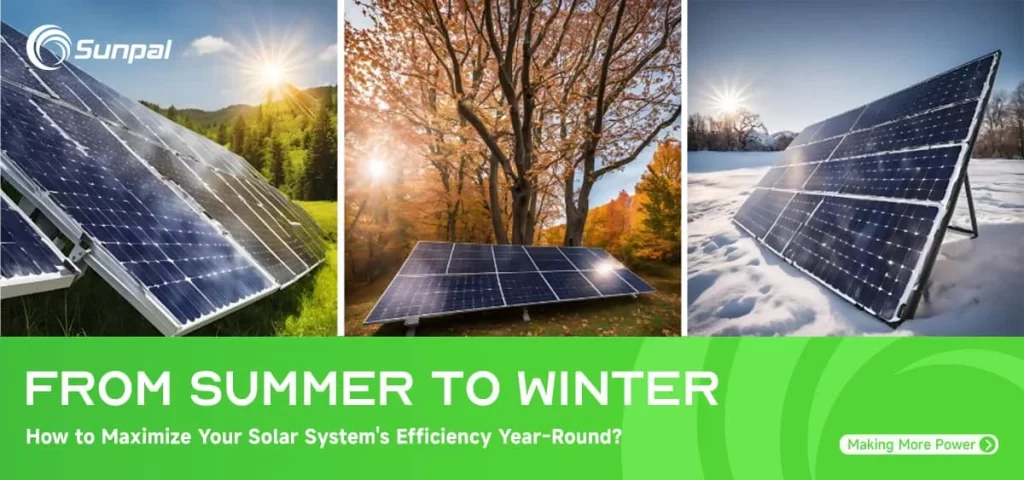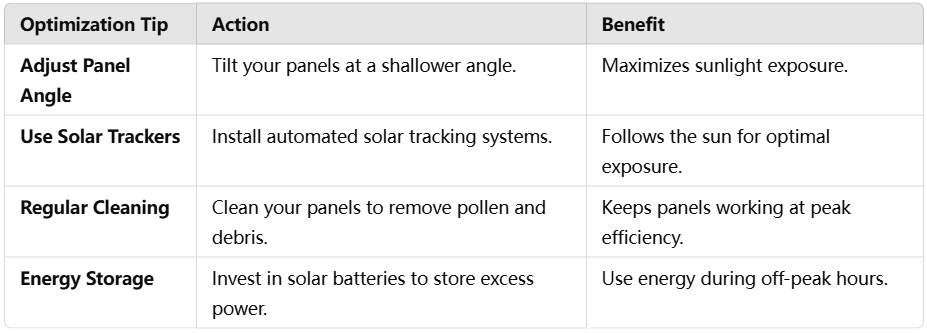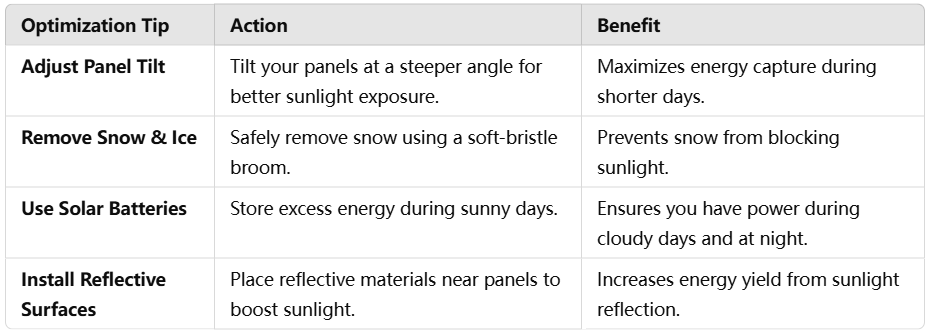
Solar energy is becoming a major player in the global shift toward clean, renewable energy. It’s reliable, efficient, and scalable. But like any power source, it has its challenges. One of the most common concerns among solar energy users is seasonal fluctuations in solar panel output. The intensity of sunlight varies across the seasons, and so does the power you can generate from your solar panels. The key question is: how do you maintain peak solar energy production year-round?
Whether you're looking to install a solar system for your home, business, or industrial project, understanding how to manage seasonal energy production is crucial. In this article, we’ll dive into the seasonal challenges of solar energy and reveal the secrets to maximizing your solar generator’s output no matter the time of year.
The Seasonal Solar Generator Challenge
Solar power is a fantastic, sustainable energy solution, but it’s not without its nuances. The amount of sunlight your solar panels receive varies depending on several factors, including:
1. Season of the year – The angle of the Earth relative to the sun shifts over time, resulting in longer or shorter days.
2. Geographical location – Regions closer to the equator receive more consistent sunlight, while those near the poles experience greater seasonal variation.
3. Weather conditions – Cloud cover, snow, and rainfall can impact solar panel efficiency.
So, while you may enjoy abundant sunlight in the summer months, you might notice a significant drop in solar output as winter approaches. This variation doesn't mean your solar system is less efficient; it simply means you need to adjust your setup and strategies to make the most of what the seasons offer.
Maximizing Solar Output: Key Seasonal Adjustments
1. Spring and Summer: Maximizing Solar Energy Generation
Spring and summer are typically when solar systems produce their maximum output. With longer daylight hours and the sun positioned at a higher angle, solar panels receive optimal sunlight, resulting in higher energy generation. But to ensure that you're getting the most out of these seasons, there are a few things you can do.
How to Optimize Solar Output in Spring and Summer:
- Panel Angle Adjustment: The sun is high in the sky during these months, so tilting your solar panels to a shallower angle will help them capture the maximum amount of sunlight. If you use adjustable mounts, you can further optimize the angle throughout the year.
- Solar Tracking Systems: If you want to get serious about maximizing your output, solar trackers are a great investment. These systems automatically adjust the tilt of your solar panels throughout the day to follow the sun's path, ensuring that your panels are always positioned to capture the most light.
- Regular Cleaning: During the spring, pollen and debris can collect on your panels, reducing their efficiency. Regular cleaning (every few months) will help maintain their performance.
- Energy Storage: If you produce more energy than you can use during the day, make sure you store the excess in solar batteries. These batteries will allow you to use that energy in the evening or on cloudy days.
Tips for Spring & Summer Solar Optimization:

2. Fall and Winter: Overcoming the Seasonal Challenges
When the days get shorter and the sun's intensity weakens, solar panel performance naturally drops. This doesn't mean your system won't work in the winter months, but it will require some adjustments. If you're serious about ensuring consistent energy production throughout the year, it's essential to understand how to manage these seasonal changes.
How to Optimize Solar Output in Fall and Winter:
- Adjust Panel Tilt for Low Sun Angles: As the sun moves lower in the sky during the winter, it’s crucial to tilt your panels at a steeper angle to capture as much sunlight as possible. In most cases, increasing the angle by 10 to 15 degrees can significantly boost performance.
- Remove Snow and Ice: In colder climates, snow and ice buildup can block sunlight and reduce the effectiveness of your solar panels. Gently brush off any snow accumulation with a soft-bristled broom or rake.
- Utilize Solar Batteries: The shorter daylight hours mean that you might not generate enough energy to meet your daily needs. Storing energy in solar batteries when the sun is out will ensure you have power even during cloudy or dark days.
- Reflective Surfaces: In areas where snow is common, snow reflection can increase the amount of sunlight hitting your panels. This is especially true for bifacial panels like those offered by Sunpal Solar, which capture light on both the front and back sides of the panel. Installing reflective surfaces around your panels can enhance this effect and increase output.
Tips for Fall & Winter Solar Optimization:

Advanced Technologies to Maximize Year-Round Solar Output
If you're serious about ensuring your solar system is working at peak efficiency, consider adding some advanced technologies to your setup. These innovations can help you maximize solar power production in every season, ensuring you get the most out of your investment.
Key Advanced Technologies:
1. Solar Trackers: Automatic Sun-Following for Maximum Efficiency
Solar trackers adjust the tilt and angle of your solar panels throughout the day to follow the sun's movement. This ensures your panels are always positioned to capture the most sunlight. While trackers are an added expense, they can significantly increase the energy output of your system, especially in regions with fluctuating sunlight.
2. Bifacial Solar Panels: Harnessing Light from All Angles
Traditional solar panels only capture light that directly hits the front of the panel. Bifacial solar panels, like Sunpal Solar’s TOPCon BiMAX5N series, are designed to capture light from both the front and back of the panel. This double-sided technology can boost energy generation, especially in environments with reflective surfaces like snow or sand.
3. Energy Management Systems: Smarter Solar Energy
An Energy Management System (EMS) uses artificial intelligence (AI) and IoT sensors to optimize the performance of your solar system. With real-time monitoring, you can adjust your energy use based on the weather, time of day, and your energy needs, ensuring your system is working efficiently and effectively year-round.

How Does Sunpal Solar Help Maximize Output Year-Round?
At Sunpal Solar, we understand the complexities of seasonal solar performance, and we’ve engineered our products to help you maximize your energy production all year. Here’s why you should trust us with your solar needs:
1. High-Efficiency Panels for All Conditions: Our TOPCon BiMAX5N 580W bifacial solar panels are engineered to provide high efficiency and reliable performance, even in extreme weather conditions.
2. Custom Solutions for Every Need: Whether you're looking for a residential solar setup or a commercial installation, we offer customized solar solutions tailored to your energy needs and seasonal challenges.
3. Advanced Technology Integration: From solar trackers to energy storage and advanced monitoring systems, we provide a suite of technologies to enhance your solar system’s performance year-round.
4. Trusted Manufacturer: When you choose Sunpal Solar, you’re choosing a reliable manufacturer with a track record of delivering high-performance solar solutions. Our products have been trusted in over 100 countries worldwide.
Success Stories: Sunpal Solar in Action
- Summer Success:
In a hot, sunny region, a Sunpal Solar installation provides maximum energy production during the summer months by adjusting the panel angle and using solar batteries to store excess energy.
- Winter Resilience:
In a snow-covered region, Sunpal’s bifacial panels continued to produce high energy output despite the low sun angle, thanks to snow reflection and optimized tilt adjustments.
FAQs
1. How does Sunpal Solar handle seasonal variations in solar energy?
Sunpal Solar’s high-efficiency TOPCon BiMAX5N panels, energy storage solutions, and customized installations ensure consistent performance year-round, adapting to each season’s unique challenges.
2. Can I install solar trackers for year-round optimization?
Yes, solar trackers can be installed to adjust the angle of your panels throughout the day, optimizing exposure and boosting energy production, especially in winter and summer.
3. What maintenance is required during winter?
In winter, it’s important to remove snow safely from your panels and check for ice buildup. Also, ensure the panels are angled properly for the low sun angle.
Conclusion: Maximize Your Solar Generator’s Output Year-Round
Seasonal solar output fluctuations are natural, but with the right strategies and Sunpal Solar's advanced solutions, you can ensure your system delivers reliable, high-performance energy throughout the entire year. Ready to take control of your energy production? Consult Sunpal Solar for customized solar solutions that meet your specific needs.
Maximize your energy production today with Sunpal Solar’s advanced, efficient solar solutions.
